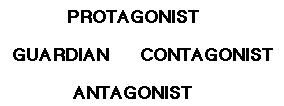Dramatica: A New Theory Of Story
By Melanie Anne Phillips & Chris Huntley
Chapter 5
Objective Character Functions
Drivers and Passengers
Dynamic Pairs
We have now created four distinct pairs of Archetypal Characters. Each pair presents the birthing ground of a particular kind of conflict. Two Characters bonded in such a relationship constitute a Dynamic Pair. Here are the Eight Archetypal Characters organized by Dynamic Pairs.

Functions of Dynamic Pairs
We can easily see how these Archetypal pairs represent a broad analogy to a human mind dealing with a problem. The Protagonist represents the desire to work at resolving the problem. Its Dynamic Pair, the Antagonist represents the desire to let the problem grow. As with the Archetypal Characters, we all face an internal battle between making decisions based upon Reason or upon Emotion. Like the functions of the Sidekick and Skeptic, the Story Mind will contain a struggle between Faith and Disbelief. And finally in an Archetypal sense, the Mind will be torn between the Contagonist’s temptation for immediate gratification and the Guardian’s counsel to consider the consequences.
Forcing the Story Forward
There is another useful grouping of the Archetypal Characters which helps uncover their essential Elements. Four of the characters seem to be the prime movers of the story, and it is their interactions that determine the thrust of the effort to address the story’s problem. The other four are “back seat drivers” — perhaps highly interested in the outcome, but rather than forcing the plot, they influence those who do force the plot. Remember, these descriptions are only applicable in a general way but serve to make comparisons between similar traits of characters. In Dramatica, we group four similar items that are interrelated into a simple table called a quad. So, we can create a quad of Driver Characters and a quad of Passenger Characters.
Drivers
The Driver Quad
Quad One: The Driver Characters
In simple stories, the Protagonist, Antagonist, Guardian, and Contagonist are all major drivers of the story. Whatever the object of their efforts, Protagonist will be trying to achieve it, Antagonist will be trying to prevent its achievement, Guardian will act to aid the achievement, and Contagonist will act to hinder (although Guardian and Contagonist may not be directly concerned with the goal itself or even each other). Regardless of their personal levels of awareness, each of these Characters seen Objectively acts with a unique drive that represents a basic Motivation of the Story Mind.
For example, if the Protagonist wants to build a shopping center, the Antagonist will not want it built. The Contagonist might get an injunction delaying construction so it can profit from a stock deal, even though it may like to see the center built eventually, and the Guardian might find a legal loophole to overturn the injunction, perhaps just as a by-product of another matter it is representing in court.
Remember, these Objective Characters are not judged by how THEY see the story, but how WE see them affecting the story.
Passengers
The Passenger Quad
Quad Two: The Passenger Characters
Unlike the first quad, these four Characters are not the prime movers of the story, but rather ride the coattails of the Driver Characters. If not for the Drivers, the Passengers would not even be involved with the problem. Each represents an approach or attitude in the story: Sidekick is forever faithful while Skeptic is forever doubting; Reason acts on the basis of logic and Emotion responds from feelings. Of course, each of these Characters also has its own motivations, but seen Objectively as part of the Story Mind they represent different approaches and attitudes toward solving the problem.
Before we sub-divide the Archetypal Characters into their basic Elements, let’s get a better feel for them by examining the Drivers and Passengers in several well known stories.
Drivers and Passengers in Star Wars
Archetypes in Star Wars
Most people would agree that Luke Skywalker is the Protagonist in Star Wars and Dramatica sees it the same way. The Empire itself, embodied in the Gran Mof Tarkin and his troops, is the force diametrically opposed to the story’s goal of destroying the Death Star, and is therefore the Antagonist. Obi Wan Kenobi is the Guardian, protecting Luke and company and providing “moral” guidance, whereas Darth Vader is the Contagonist, representing the temptation of the “Dark side of the Force” and hindering progress at every turn.
Han Solo functions as the Skeptic, arguing his disbelief in the Force as well as his opposition to just about every course of action anyone tries to take. R2D2 and C3PO jointly fill the role of Sidekick, forever faithful to whomever they are assigned. Princess Leia is Reason, coldly calculating (although this is tempered in the storytelling), calm-headed and the real planner of the group. Chewbacca, in contrast, responds frequently with little or no thought and acts solely on the basis of his feelings, which clearly defines him as Emotion.
(It should be noted that R2D2 and C3PO have a well developed sub-plot between them, that is forefront as the movie opens. This gives them much more personality and versatility, and spells out differences between them that would not occur if they both simply shared the sidekick function. Sub-plots are dealt with later in the Storyweaving section of this book.)
Drivers and Passengers in Star Wars
Having delineated our eight characters in Star Wars, let us organize them into Drivers and Passengers.
Driver Characters
Passenger Characters
Drivers and Passengers in The Wizard of Oz
Archetypes in The Wizard of Oz
We can label Dorothy as the Protagonist in The Wizard of Oz with some confidence. Certainly the Scarecrow seems to be Reason since he is the planner of the group (“I’ll show you how to get apples!”), but he is not very calm or collected. In fact, he is quite the opposite. Similarly, the Tin Man looks like Emotion as he cries in the poppy field, yet he is anything but frenetic when he rusts himself from the tears. Clearly, our original Archetypes don’t seem quite as true-to-form as they did in Star Wars.
Let’s file that away for later and press on. The Cowardly Lion fills the role of Skeptic and Toto performs as the Sidekick. Glinda is an unabashed Guardian and the Wicked Witch of the West balances her as the Contagonist. But just a moment here… Doesn’t the Wicked Witch act more like an Antagonist? Indeed she does, yet she seems to also fill the same role compared to Glinda as Darth Vader fills compared to Obi Wan. Assuming for a moment that the Wicked Witch IS the Antagonist, then who is the Contagonist?
There is only one major character yet unaccounted for — the Wizard himself.
The Wizard as Contagonist? Somehow it doesn’t sound quite right. At this point it becomes apparent that the characters in Oz are not all exactly Archetypal. Something is going on with the Scarecrow and Tin Man and the Witch and the Wizard that doesn’t quite fit. Exploring these shortcomings of the Archetypal Character model as applied to Oz will ultimately offer some insight into the essential character Elements.
For the time being, however, let’s pencil in the Witch as Antagonist and the Wizard as the Contagonist so we have a place to start. Here are the Eight Simple Characters of The Wizard of Oz in Quad format, ignoring any inconsistencies for the moment.
Drivers and Passengers in The Wizard of Oz
Driver Characters
Passenger Characters
Drivers and Passengers in Jaws
Archetypes in Jaws
Chief Brody fills the Protagonist’s shoes in Jaws, and few would doubt that the Shark is the Antagonist. Hooper, with all his gizmos, takes the Reasonable stand, while Quint, who simply hates sharks, functions as Emotion. The Mayor is a strong Contagonist and Brody’s wife is a weak Sidekick although it almost seems as if Hooper fills that role sometimes as well. Once again, more versatility is needed than the Archetypal Characters provide.
We still need a Guardian — someone to protect Brody as well as stress the proper moral course. Simply put, Jaws has no character that performs BOTH functions. Rather, the moral half of the Guardian’s role is played by Hooper who reminds Brody of his duty and urges him into taking action against the shark problem, while the protective role is filled in turn by the land itself, Hooper’s boat, and ultimately Quint’s boat.
Non-Archetypal Roles in Jaws
There is no reason why a character must be a person. A boat can be a player as well as a person, as long as it can demonstrate its function to the audience. Again, in Dramatica, the point of a story is to illustrate all aspects of the Story Mind dealing with a problem. As long as each aspect is accounted for, the specific carrier of that Element is structurally irrelevant and may only have storytelling ramifications.
So far we have not determined the Skeptic in Jaws. Who refuses to believe evidence of the shark problem or the need for taking action against it? Clearly the Mayor embodies that characteristic well, and yet was previously identified as the Contagonist. Obviously some “doubling up” is going on here. If we look at who is across from whom in quad form, we can see some of the basic dramatic Character conflicts in Jaws.
Drivers and Passengers in Jaws
Driver Characters
Passenger Characters

From this breakdown, we see a good example in both the Mayor and Hooper of single players who actually portray two distinct Archetypal characters. The Mayor functions as Contagonist and Skeptic, whereas Hooper portrays both Guardian and Reason. Some of these broad labels fit better than others, which is why there are actually some Complex Character arrangements in Jaws as well, that do not quite fall into the strict Archetypal mold.








